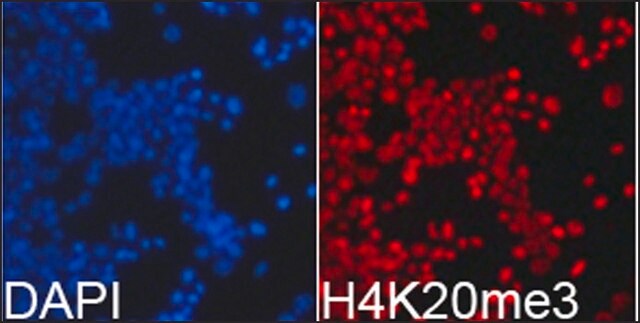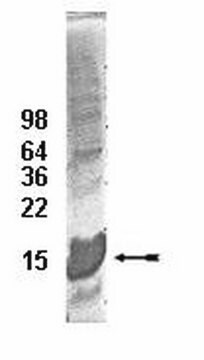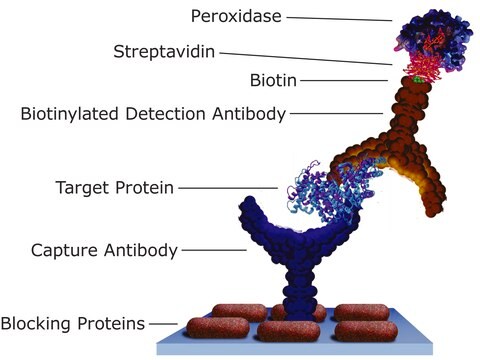17-10047
ChIPAb+ Histone H4 - ChIP Validated Antibody and Primer Set, rabbit monoclonal
from rabbit
Sinónimos:
H4, Histone H4, H4 histone family, member A, histone 1, H4a, histone cluster 1, H4a
Iniciar sesiónpara Ver la Fijación de precios por contrato y de la organización
About This Item
Código UNSPSC:
12352203
eCl@ss:
32160702
NACRES:
NA.32
Productos recomendados
origen biológico
rabbit
Nivel de calidad
clon
monoclonal
reactividad de especies
human
fabricante / nombre comercial
ChIPAb+
Upstate®
técnicas
ChIP: suitable
immunoprecipitation (IP): suitable
western blot: suitable
Nº de acceso NCBI
Nº de acceso UniProt
Condiciones de envío
dry ice
Descripción general
All ChIPAb+ antibodies are individually validated for chromatin precipitation, every lot, every time. Each ChIPAb+ antibody set includes control primers (tested every lot by qPCR) to biologically validate your IP results in a locus-specific context. The qPCR protocol and primer sequences are provided, allowing researchers to validate ChIP protocols when using our antibody in their chromatin context. Each set also includes a negative control antibody to ensure specificity of the ChIP reaction.
The ChIPAb+ Histone H4 set includes the Histone H4 antibody, a negative control antibody (normal rabbit IgG), and qPCR primers which amplify a 110 bp region of human β-Globin. The Histone H4 and negative control antibodies are supplied in a scalable "per ChIP" reaction size and can be used to functionally validate the precipitation of Histone H4-associated chromatin.
The ChIPAb+ Histone H4 set includes the Histone H4 antibody, a negative control antibody (normal rabbit IgG), and qPCR primers which amplify a 110 bp region of human β-Globin. The Histone H4 and negative control antibodies are supplied in a scalable "per ChIP" reaction size and can be used to functionally validate the precipitation of Histone H4-associated chromatin.
Especificidad
Wide range of cross-reactivity expected based on sequence homology.
Inmunógeno
Epitope: a.a 25-28
KLH-conjugated synthetic peptide corres-ponding to amino acids 17-28 of Histone H4.
Aplicación
Chromatin Immunoprecipitation:
Sonicated chromatin prepared from HeLa cells (1 X 106 cell equivalents per IP) were subjected to chromatin immunoprecipitation using 2 µL of either normal rabbit IgG or 2 µL of Anti-Histone H4 antibody and the Magna ChIP A Kit (Cat. # 17-610).
Successful immunoprecipitation of total Histone H4 associated DNA fragments was verified by qPCR using ChIP Primers, β-Globin, as well as GAPDH promoter Control Primers, (Please see figures).
Data is presented as percent input of each IP sample relative to input chromatin for each amplicon and ChIP sample as indicated.
Please refer to the EZ-Magna ChIP A (Cat. # 17-408) or EZ-ChIP (Cat. # 17-371) protocol for experimental details.
Western Blot Analysis:
Representative Lot Data.
HeLa Acid Extract (Lane 1 and 3), HeLa Acid Extract from sodium butyrate treated cells (Lane 2), HeLa Acid Extract from colcemid treated cells (Lane 4) and recombinant histone H4 (Lane 5) were resolved by electrophoresis, transferred to PVDF membranes and probed with Anti-Histone H4 (1:1,000 dilution).
Proteins were visualized using a Donkey anti-rabbit IgG conjugated to HRP and visualized using a chemiluminescence detection system. (Please see figures).
Sonicated chromatin prepared from HeLa cells (1 X 106 cell equivalents per IP) were subjected to chromatin immunoprecipitation using 2 µL of either normal rabbit IgG or 2 µL of Anti-Histone H4 antibody and the Magna ChIP A Kit (Cat. # 17-610).
Successful immunoprecipitation of total Histone H4 associated DNA fragments was verified by qPCR using ChIP Primers, β-Globin, as well as GAPDH promoter Control Primers, (Please see figures).
Data is presented as percent input of each IP sample relative to input chromatin for each amplicon and ChIP sample as indicated.
Please refer to the EZ-Magna ChIP A (Cat. # 17-408) or EZ-ChIP (Cat. # 17-371) protocol for experimental details.
Western Blot Analysis:
Representative Lot Data.
HeLa Acid Extract (Lane 1 and 3), HeLa Acid Extract from sodium butyrate treated cells (Lane 2), HeLa Acid Extract from colcemid treated cells (Lane 4) and recombinant histone H4 (Lane 5) were resolved by electrophoresis, transferred to PVDF membranes and probed with Anti-Histone H4 (1:1,000 dilution).
Proteins were visualized using a Donkey anti-rabbit IgG conjugated to HRP and visualized using a chemiluminescence detection system. (Please see figures).
This ChIPAb+ Histone H4 -ChIP Validated Antibody & Primer Set conveniently includes the antibody & the specific control PCR primers.
Calidad
Chromatin Immunoprecipitation:
Sonicated chromatin prepared from HeLa cells (1 X 106 cell equivalents per IP) were subjected to chromatin immunoprecipitation using 2 µL of either normal rabbit IgG or 2 µL of Anti-Histone H4 antibody and the Magna ChIP® A Kit (Cat. #17-610). Successful immunoprecipitation of total Histone H4 associated DNA fragments was verified by qPCR using ChIP Primers, β-Globin (Please see figures).
Please refer to the EZ-Magna ChIP A (Cat. # 17-408) or EZ-ChIP (Cat. # 17-371) protocol for experimental details.
Sonicated chromatin prepared from HeLa cells (1 X 106 cell equivalents per IP) were subjected to chromatin immunoprecipitation using 2 µL of either normal rabbit IgG or 2 µL of Anti-Histone H4 antibody and the Magna ChIP® A Kit (Cat. #17-610). Successful immunoprecipitation of total Histone H4 associated DNA fragments was verified by qPCR using ChIP Primers, β-Globin (Please see figures).
Please refer to the EZ-Magna ChIP A (Cat. # 17-408) or EZ-ChIP (Cat. # 17-371) protocol for experimental details.
Descripción de destino
~11 kDa
Forma física
Anti-Histone H4 (rabbit monoclonal IgG). One vial containing 50 µL of protein A purified rabbit monoclonal IgG supernatant in buffer containing 0.1 M Tris-Glycine (pH 7.4), 150 mM NaCl with 0.05% sodium azide before addition of glycerol to 40%. Store at -20°C.
Normal Rabbit IgG. One vial containing 75 µg of normal rabbit IgG in 75 µL storage buffer. Store at -20°C.
ChIP Primers, β-Globin. One vial containing 75 μL of 5 μM of each primer specific for human β-Globin. Store at -20°C.
FOR: AGG ACA GGT ACG GCT GTC ATC
REV: TTT ATG CCC AGC CCT GGC TC
Normal Rabbit IgG. One vial containing 75 µg of normal rabbit IgG in 75 µL storage buffer. Store at -20°C.
ChIP Primers, β-Globin. One vial containing 75 μL of 5 μM of each primer specific for human β-Globin. Store at -20°C.
FOR: AGG ACA GGT ACG GCT GTC ATC
REV: TTT ATG CCC AGC CCT GGC TC
Format: Purified
Nota de análisis
Control
Includes negative control antibody (normal rabbit IgG) and primers specific for human β-Globin.
Includes negative control antibody (normal rabbit IgG) and primers specific for human β-Globin.
Información legal
MAGNA CHIP is a registered trademark of Merck KGaA, Darmstadt, Germany
UPSTATE is a registered trademark of Merck KGaA, Darmstadt, Germany
Código de clase de almacenamiento
10 - Combustible liquids
Certificados de análisis (COA)
Busque Certificados de análisis (COA) introduciendo el número de lote del producto. Los números de lote se encuentran en la etiqueta del producto después de las palabras «Lot» o «Batch»
¿Ya tiene este producto?
Encuentre la documentación para los productos que ha comprado recientemente en la Biblioteca de documentos.
CBP mediates NF-?B-dependent histone acetylation and estrogen receptor recruitment to an estrogen response element in the BIRC3 promoter.
Pradhan, M; Baumgarten, SC; Bembinster, LA; Frasor, J
Molecular and cellular biology null
Lipeng Wu et al.
Molecular cell, 49(6), 1108-1120 (2013-03-05)
Crosstalk between H2B ubiquitylation (H2Bub) and H3 K4 methylation plays important roles in coordinating functions of diverse cofactors during transcription activation. The underlying mechanism for this trans-tail signaling pathway is poorly defined in higher eukaryotes. Here, we show the following:
Xavier Brenachot et al.
Molecular metabolism, 3(6), 619-629 (2014-08-28)
Overfeeding causes rapid synaptic remodeling in hypothalamus feeding circuits. Polysialylation of cell surface molecules is a key step in this neuronal rewiring and allows normalization of food intake. Here we examined the role of hypothalamic polysialylation in the long-term maintenance
David Michod et al.
Neuron, 74(1), 122-135 (2012-04-17)
Activity-dependent modifications of chromatin are believed to contribute to dramatic changes in neuronal circuitry. The mechanisms underlying these modifications are not fully understood. The histone variant H3.3 is incorporated in a replication-independent manner into different regions of the genome, including
Nuestro equipo de científicos tiene experiencia en todas las áreas de investigación: Ciencias de la vida, Ciencia de los materiales, Síntesis química, Cromatografía, Analítica y muchas otras.
Póngase en contacto con el Servicio técnico






